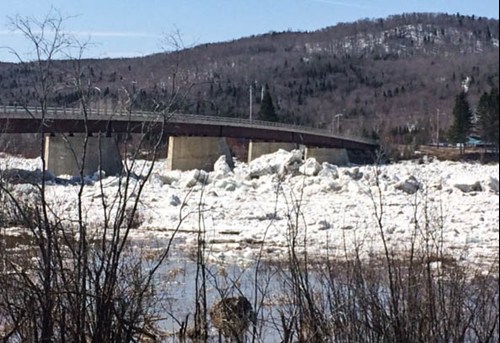Mactaquac and the Freshet
April 22 2015, 09:36 AM
After the winter that just kept on giving, the signs of spring are welcome as we put away our snow shovels for another season. With temperatures starting to warm up across the province, this is also the time when many New Brunswickers are closely watching rising water levels in the rivers and in some cases, already dealing with flooding
Now that the spring freshet is upon us, NB Power has been hard at work with the New Brunswick Emergency Measures Organization and other local partners monitoring ice conditions, snow pack, precipitation accumulation and weather patterns.
How it works
NB Power operates six run-of-river hydroelectric generating stations across New Brunswick- the largest being Mactaquac. Run of river facilities depend on the constant flow of the river. To generate electricity, the water flowing into the station is directed down and through turbines, providing the energy to spin the generators. Run-of-river stations have no ability to hold back water. All water that comes into the station must go out - especially during the spring freshet when water flows are higher than normal.
Hydro generating stations like Mactaquac contribute energy to our grid year-round, but sometimes during the spring thaw we have more water flowing into our stations than we’re able to generate. When all of the turbines are operating at full capacity in the station, operators open the spill gates to let out this excess water.
Ice Jams

Ice jams on the other hand do hold back water and ice from moving freely downstream. Ice jams have been the cause of major flood events in the past here in New Brunswick, like those in Perth-Andover, Fredericton and St. George.
These jams happen when the ice in the river breaks up, sticks together and hits the bottom of the river. Like an iceberg in the ocean, what we see from land is only the tip of the ice jam in the river. Once the ice jams, it interrupts the natural flow of the river and the water behind it backs up, causing water levels to rise. Some areas of the river are more likely to experience ice jams than others.
Here are a few other factors that can contribute to ice jams:
- Two rivers joining, like the Tobique and Saint John rivers
- Elements like islands, low bridges and sharp bends can narrow or block the path for ice movement
- Thicker ice in the river
- Shallow areas of river
Severe flooding happens when those factors combine with the following:
- Speed and volume of river flow
- Strength of ice cover
- Snow depth
- Precipitation
- How quickly the temperatures rise
Be safe
It is so important for people to stay away from the water and ice near these hydro stations in the spring. Ice may appear to be solid, but is inconsistent due to changing water flows below. Calm water on the river below a hydro station can quickly turn into rapids with a strong undertow.
Watch for warning signs, boom, buoys and barriers around NB Power hydro stations.
Have an idea for a future blog post? Let us know in the comments section below or email us.
Categories How it works









